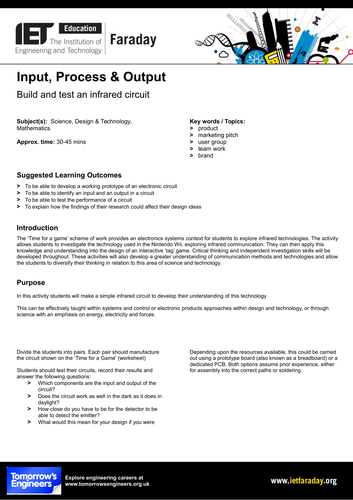


In this activity students will make a simple infrared circuit to develop their understanding of this technology.
Our “Time for a Game” worksheet introduces students to infrared technologies, using the technology behind the Nintendo Wii as a real-life example.
Through building and testing an infrared circuit, students will learn to identify which components are inputs and outputs, a critical skill that deepens their understanding of how electronic systems function and enables them to design more complex circuits in the future.
This is one of a set of resources developed to aid the teaching of the secondary national curriculum, particularly KS3. It has been designed to support the delivery of key topics within science and design and technology (DT). This can be effectively taught within systems and control, or electronic products approaches within design and technology, or through science with an emphasis on energy, electricity and forces.
Activity: Build and test an infrared circuit
Students will work in pairs to construct the circuit outlined in the “Time for a Game” worksheet. After building their circuits, they will test their functionality under different conditions and answer key questions about their design. This hands-on approach will allow students to identify the input and output components of the circuit, understand its performance in various lighting conditions, and consider how these factors would influence the design of a Wii controller.
The engineering context
By building and testing an infrared circuit, students will gain a practical understanding of the engineering process, from conceptualization to testing. Furthermore, this activity will inspire students to consider a career in engineering, as they experience firsthand the creativity, critical thinking, and problem-solving that this field entails.
Suggested learning outcomes
Students will develop a working prototype of an electronic circuit, gaining practical experience in the process. They will learn to identify inputs and outputs in a circuit and test its performance under different conditions. Furthermore, they will have the opportunity to apply their findings to hypothetical design situations, promoting critical thinking and problem-solving skills. This activity will teach students the ability to explain how their research findings could affect their design ideas, enhancing their communication skills and technological literacy.
Download our activity sheet for free!
The activity sheet includes teachers’ notes, useful web links, and links (where appropriate) to the national curriculum in each of the four devolved nations; England, Northern Ireland, Scotland and Wales.
All activity sheets and supporting resources are free to download and all the documents are fully editable, so you can tailor them to your students’ and your schools’ needs.
Please do share your highlights with us @IETeducation.
Something went wrong, please try again later.
not what I was looking for
Report this resourceto let us know if it violates our terms and conditions.
Our customer service team will review your report and will be in touch.